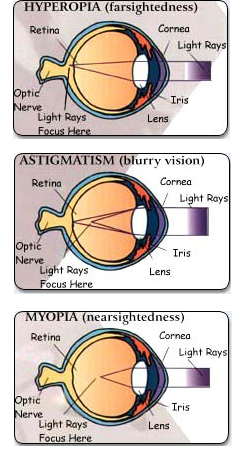
 The function of the eye is to see clearly the objects around us. The inability of the eye to accurately focus the rays of light coming from distance on the retina is called refractive error. This condition may be either because the eye is too short or long in length, or because the cornea or lens does not have the required refractive power. There are three types of refractive errors:
The function of the eye is to see clearly the objects around us. The inability of the eye to accurately focus the rays of light coming from distance on the retina is called refractive error. This condition may be either because the eye is too short or long in length, or because the cornea or lens does not have the required refractive power. There are three types of refractive errors:
Myopia (near-sight): this is the condition in which the eye is too long and the light is focused in front of the retina. Distant objects are blurred but the near objects are seen clearly. The eye has too much optical power and to correct it the optical power is reduced by either minus glasses or contact lenses, or by surgery.
Hypermetropia (long-sight): this is the condition in which the eye is too short and the light is focused behind the retina. The eye has less optical power than is needed. When young the eye can use the lens within the eye to compensate, but reading glasses are needed at a relatively early age. Later, distance glasses (plus) are needed as well, such that glasses for distance and near are required.
Astigmatism: this is the condition where the eye does not focus the light evenly, usually due to cornea of the eye being more curved in one direction than the other. In other words front surface of cornea is not round like a ball and tennis but is like a baseball or egg or back of spoon . It may occur on its own or may be associated with myopia or hypermetropia.
Presbyopia is the normal aging process, where the lens progressively loses its capacity to increase its power for near vision (loss of accommodation). The distance vision may be normal, but the near vision becomes blurred with age greater than about 45 years. This is corrected by wearing reading glasses (plus) for the near work. This condition may occur in itself or may be present along with pre-existing myopia, hypermetropia or astigmatism.
The refractive errors may be treated by either of the following ways:
- Glasses:this is the simplest and most popular way of correcting refractive errors.
- Contact lens:this option is cosmetically much better though the maintenance and cleaning of contact lenses may be cumbersome. There is also a slight risk of infection to the cornea, if the contact lenses are not cleaned properly before use.
- Refractive surgeries:these are increasingly becoming popular with the advent of more predictable laser treatments. ICL / LASIK
